Charles E W Bean, Diaries, AWM38 3DRL 606/119/1 - Photostats - Part 1
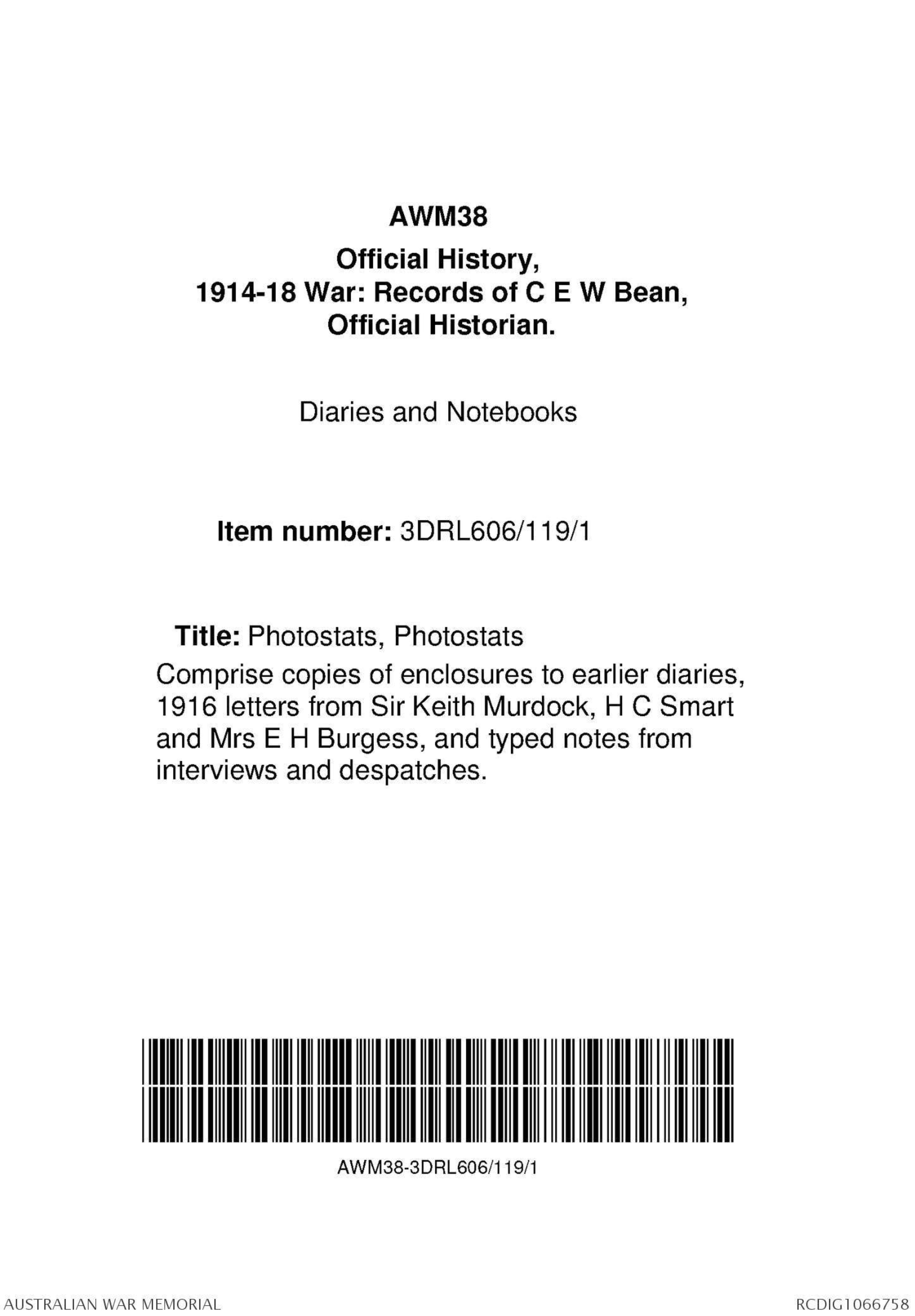
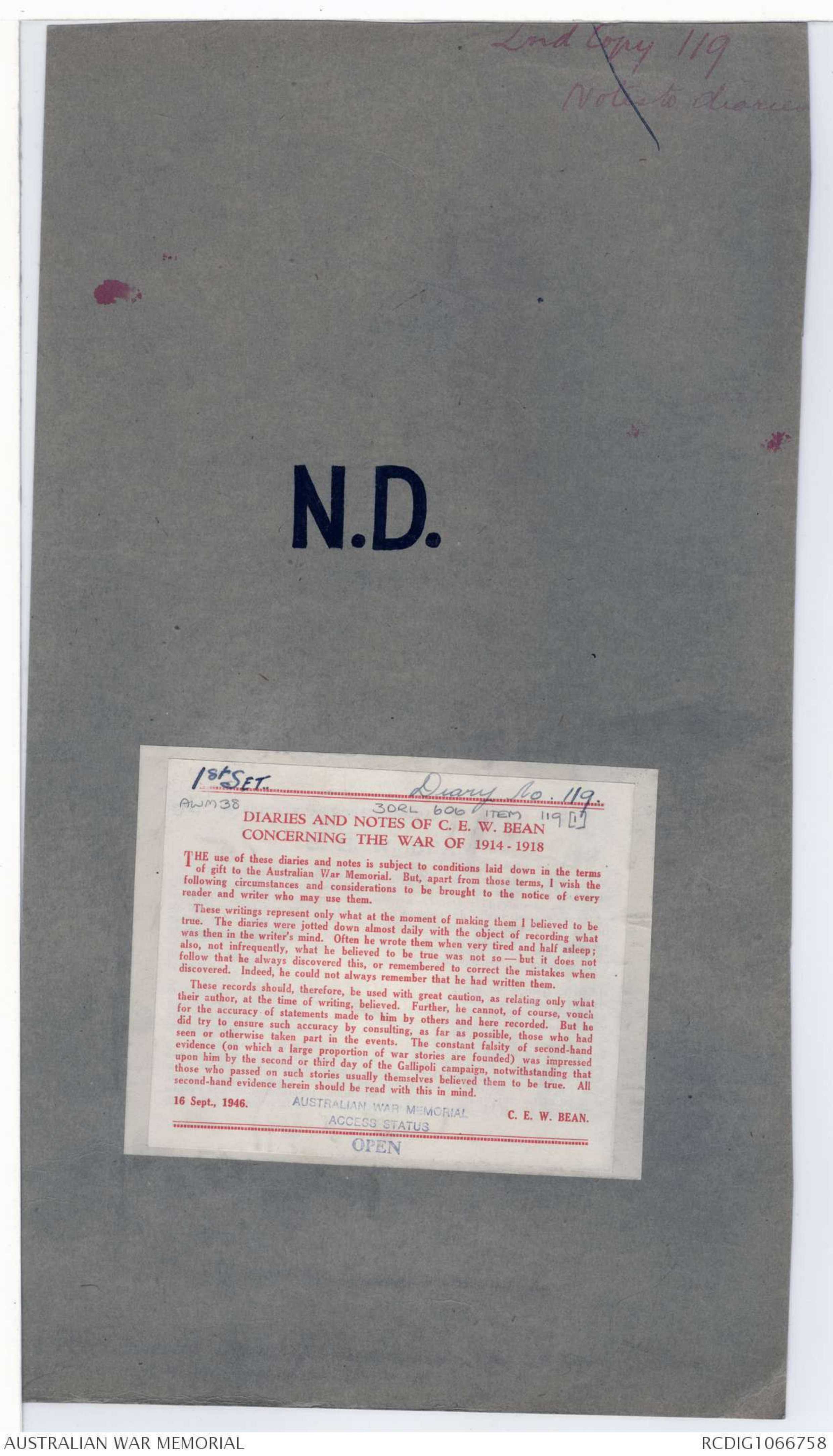

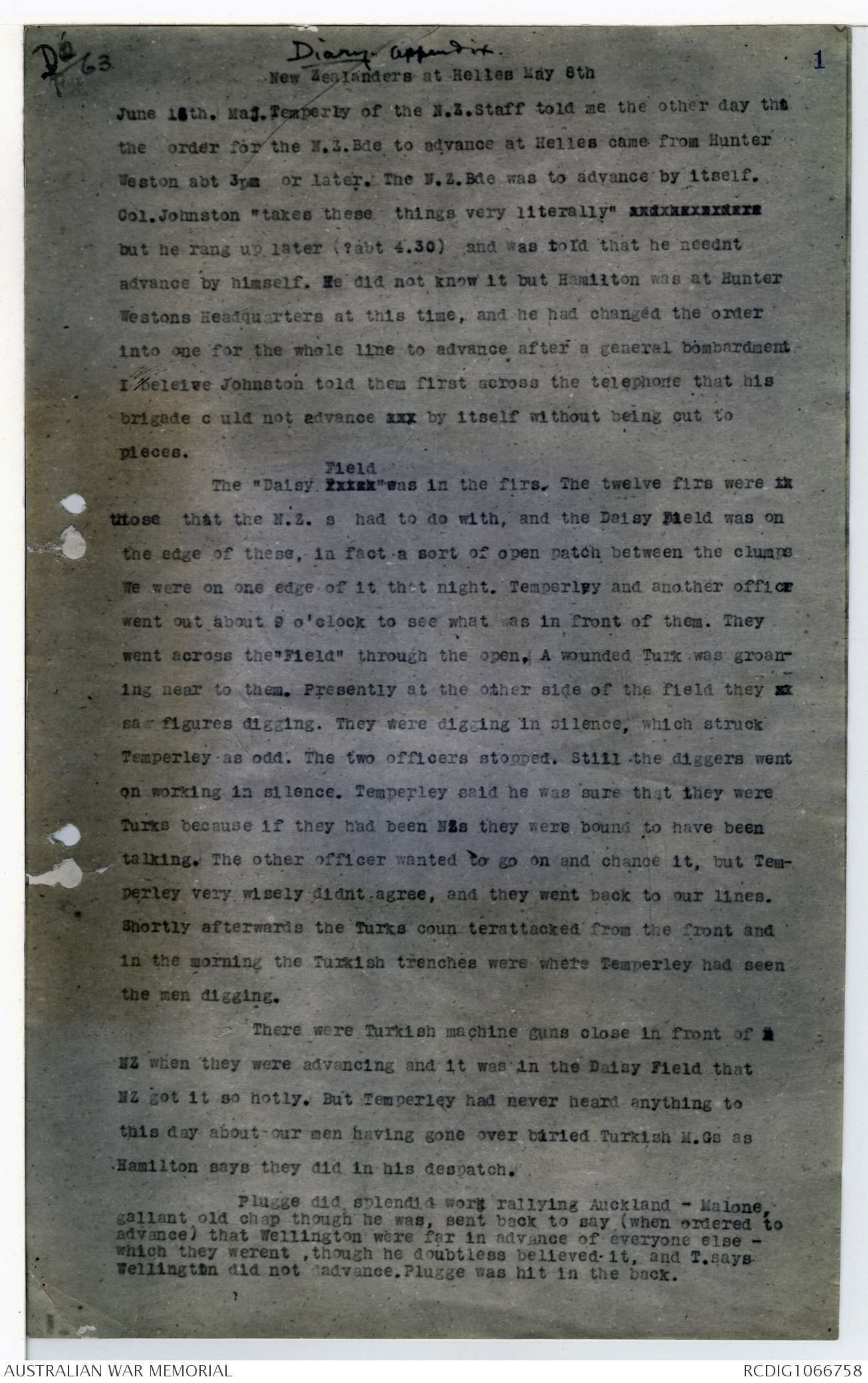
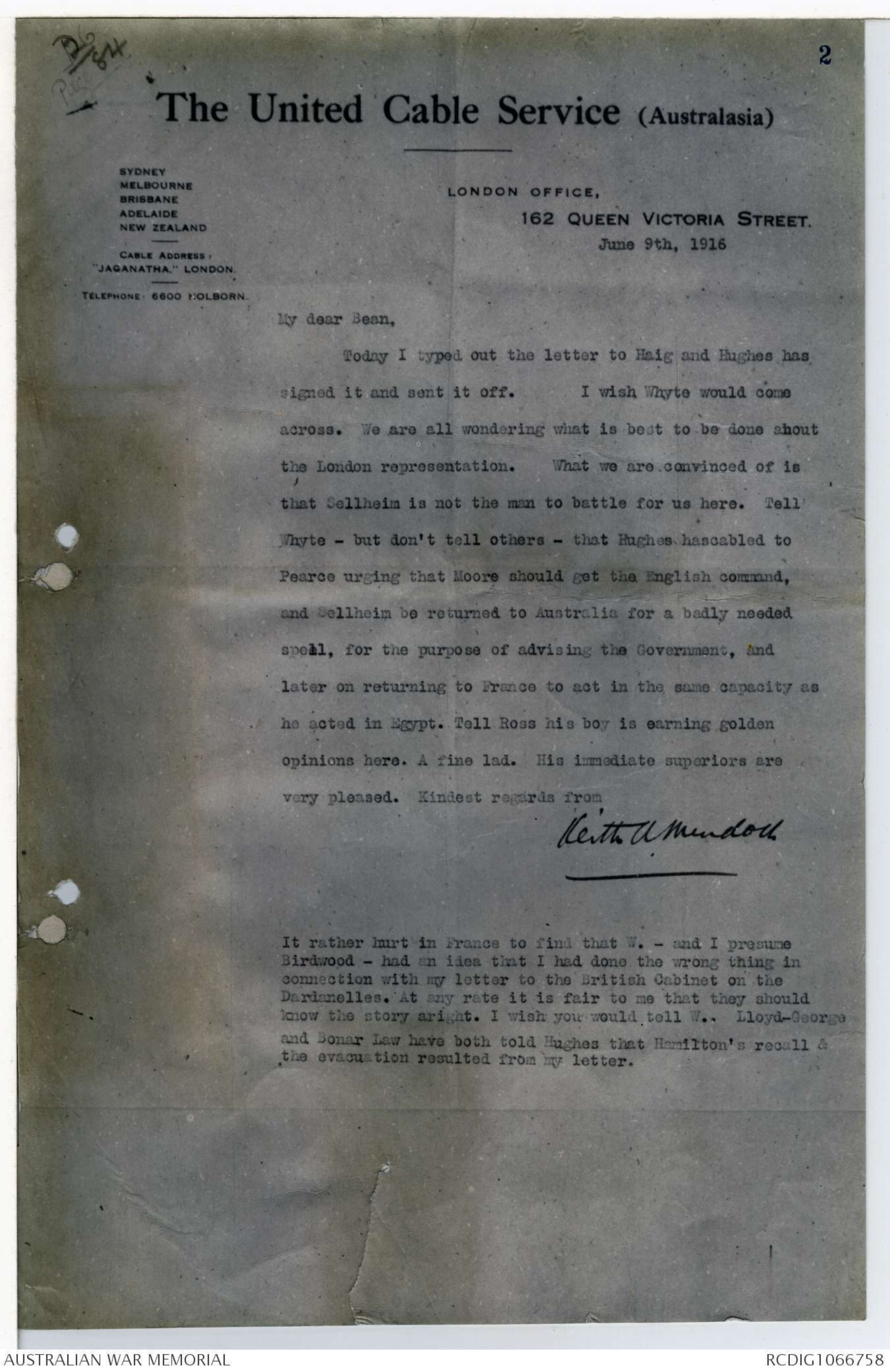
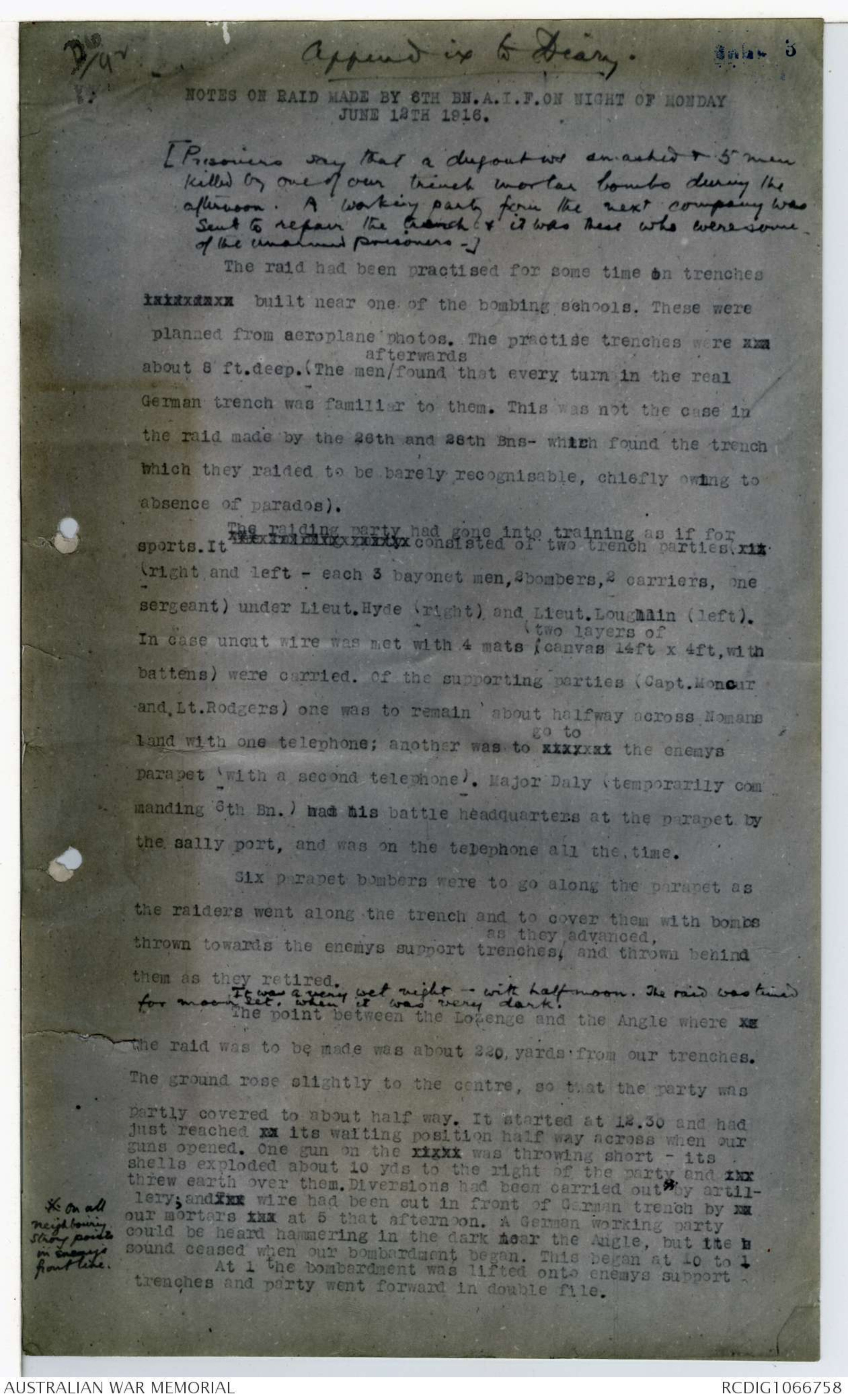
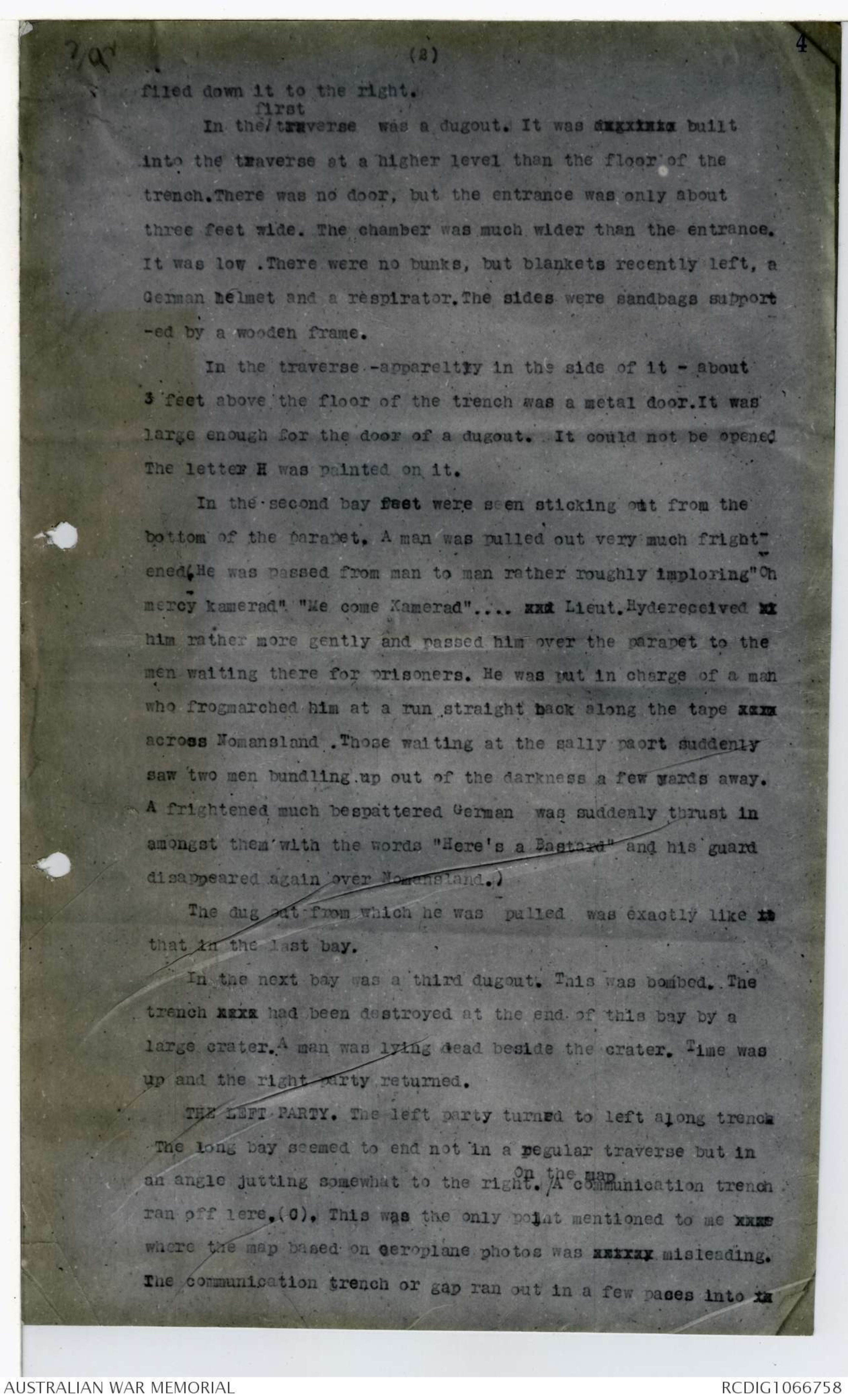
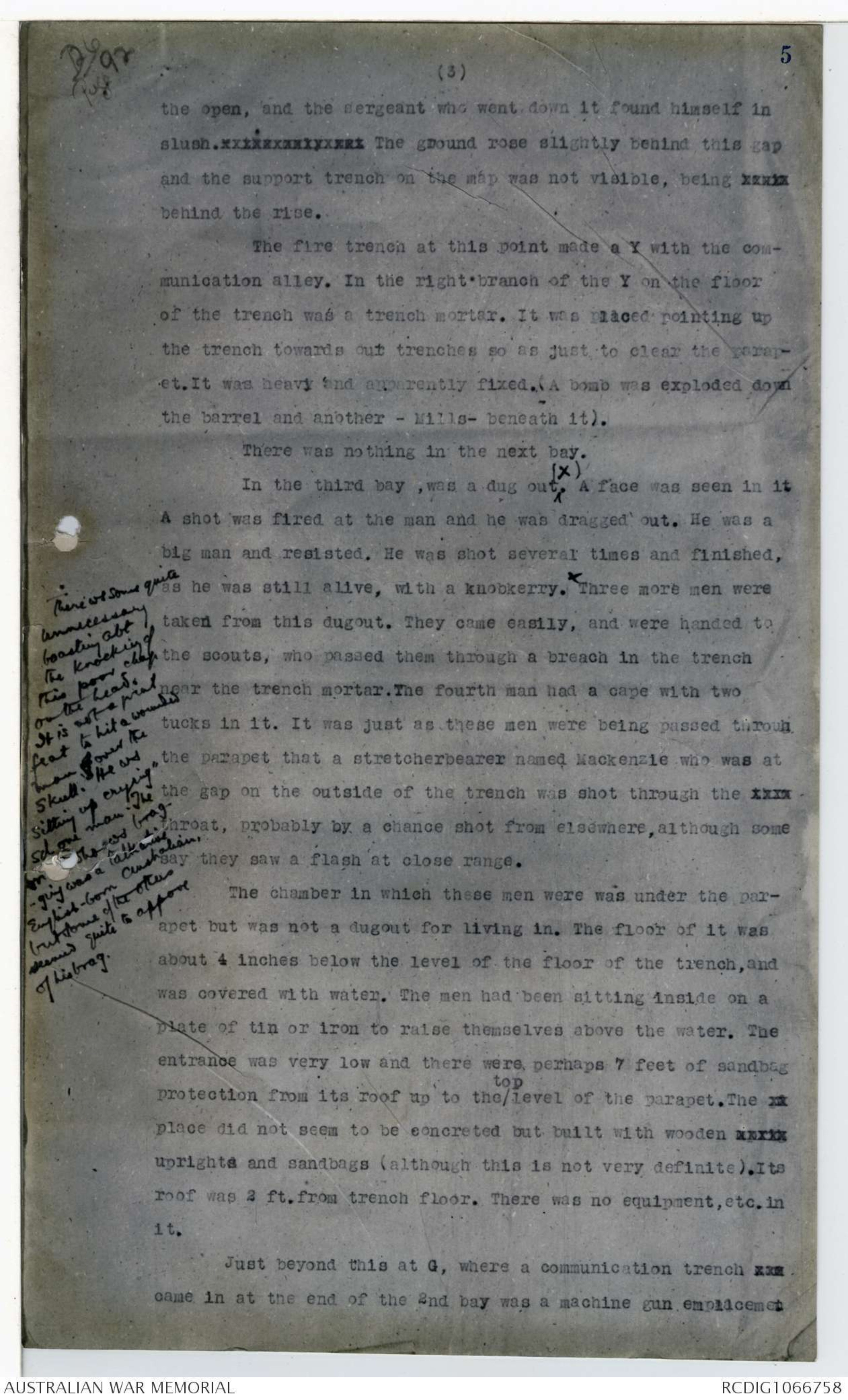
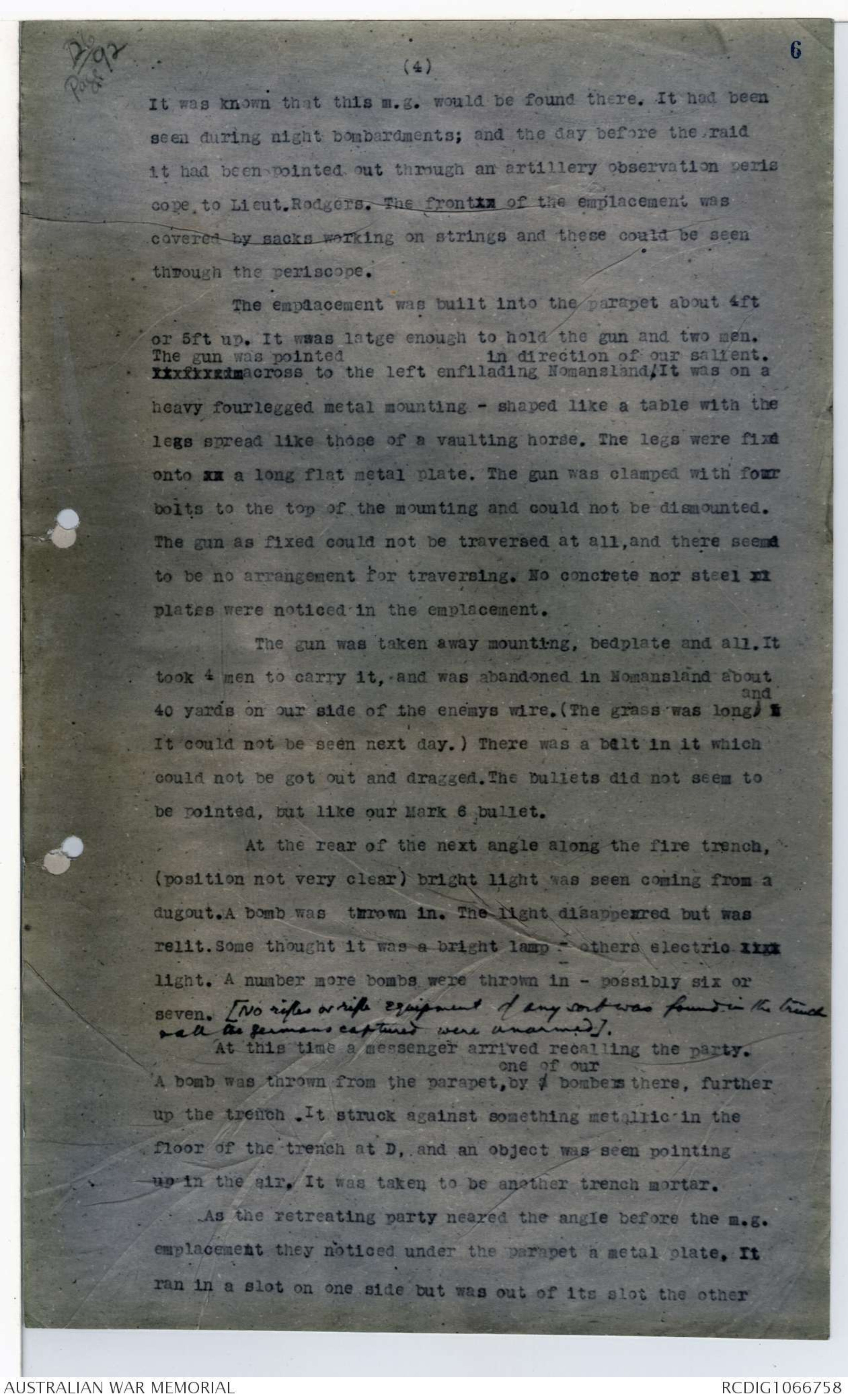
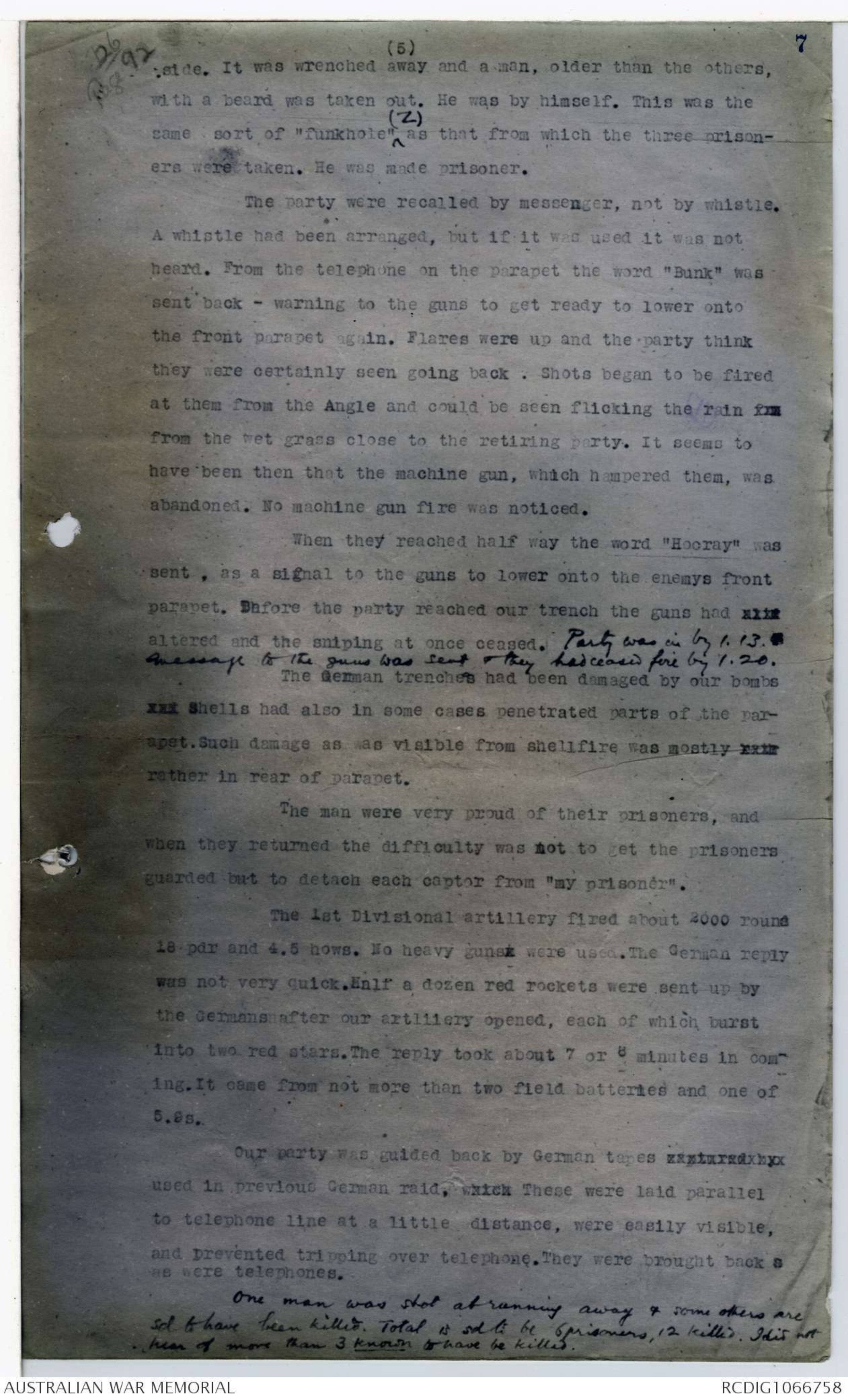
AWM38
Official History,
1914-18 War: Records of C E W Bean,
Official Historian.
Diaries and Notebooks
Item number: 3DRL606/119/1
Title: Photostats, Photostats
Comprise copies of enclosures to earlier diaries,
1916 letters from Sir Keith Murdock, H C Smart
and Mrs E H Burgess, and typed notes from
interviews and despatches.
AWM38-3DRL606/119/1
AUSTRALIAN WAR MEMORIAL RCDIG1066758
2nd Copy 119
Notes to diaries
N.D.
1st SET. Diary No. 119.
AWM 38 3DRL 606 ITEM 119 [1]
DIARIES AND NOTES OF C. E. W. BEAN
CONCERNING THE WAR OF 1914-1918
THE use of these diaries and notes is subject to conditions laid down in the terms
of gift to the Australian War Memorial. But, apart from those terms, I wish the
following circumstances and considerations to be brought to the notice of every
reader and writer who may use them.
These writings represent only what at the moment of making them I believed to be
true. The diaries were jotted down almost daily with the object of recording what
was then in the writer's mind. Often he wrote them when very tired and half asleep;
also, not infrequently, what he believed to be true was not so—but it does not
follow that he always discovered this, or remembered to correct the mistakes when
discovered. Indeed, he could not always remember that he had written them.
These records should, therefore, be used with great caution, as relating only what
their author, at the time of writing, believed. Further, he cannot, of course, vouch
for the accuracy of statements made to him by others and here recorded. But he
did try to ensure such accuracy by consulting, as far as possible, those who had
seen or otherwise taken part in the events. The constant falsity of second-hand
evidence (on which a large proportion of war stories are founded) was impressed
upon him by the second or third day of the Gallipoli campaign, notwithstanding that
those who passed on such stories usually themselves believed them to be true. All
second-hand evidence herein should be read with this in mind.
16 Sept., 1946. C. E W. BEAN.
AUSTRALIAN WAR MEMORIAL
ACCESS STATUS
OPEN
Diagram – see original document
[*D6/P 63*] 1
Diary Appendix.
New Zealanders at Helles May 8th
June 18th. Maj. Temperly of the N.Z. Staff told me the other day tha
the order for the N.Z. Bde to advance at Helles came from Hunter
Weston abt 3pm or later. The N.Z. Bde was to advance by itself.
Col. Johnston "takes these things very literally" andxhexxxxxxx
but he rang up later (?abt 4.30) and was told that he neednt
advance by himself. He did not know it but Hamilton was at Hunter
Westons Headquarters at this time, and he had changed the order
into one for the whole line to advance after a general bombardment
I believe Johnston told them first across the telephone that his
brigade could not advance any by itself without being cut to
pieces.
The "Daisy Fxxxx Field " was in the firs. The twelve firs were xx
those that the N.Z.s had to do with, and the Daisy Field was on
the edge of these, in fact a sort of open patch between the clumps
We were on one edge of it that night. Temperley and another officer
went out about 9 o'clock to see what was in front of them. They
went across the "Field" through the open. A wounded Turk was groaning
near to them. Presently at the other side of the field they xx
saw figures digging. They were digging in silence, which struck
Temperley as odd. The two officers stopped. Still the diggers went
on working in silence. Temperley said he was sure that they were
Turks because if they had been NZs they were bound to have been
talking. The other officer wanted to go on and chance it, but
Temperley very wisely didnt agree, and they went back to our lines.
Shortly afterwards the Turks counterattacked from the front and
in the morning the Turkish trenches were where Temperley had seen
the men digging.
There were Turkish machine guns close in front of x
NZ when they were advancing and it was in the Daisy Field that
NZ got it so hotly. But Temperley had never heard anything to
this day about our men having gone over buried Turkish M.G.s as
Hamilton says they did in his despatch.
Plugge did splendid work rallying Auckland - Malone,
gallant old chap though he was, sent back to say (when ordered to
advance) that Wellington were far in advance of everyone else -
which they werent, though he doubtless believed it, and T. says
Wellington did not advance. Plugge was hit in the back.
[*D6/Page 84*] 2
The United Cable Service (Australasia)
SYDNEY
MELBOURNE
BRISBANE
ADELAIDE
NEW ZEALAND
CABLE ADDRESS
"JACANATHA" LONDON
TELEPHONE 6600 HOLBORN
LONDON OFFICE.
162 QUEEN VCTORIA STREET.
June 9th, 1916
My dear Bean,
Today I typed out the letter to Haig and Hughes has
signed it and sent it off. I wish Whyte would come
across. We are all wondering what is best to be done about
the London representation. What we are convinced of is
that Sellheim is not the man to battle for us here. Tell
Whyte - but don't tell others - that Hughes has cabled to
Pearce urging that Moore should get the English command,
and Sellheim be returned to Australia for a badly needed
spell, for the purpose of advising the Government, and
later on returning to France to act in the same capacity as
he acted in Egypt. Tell Ross his boy is earning golden
opinions here. A fine lad. His immediate superiors are
very pleased. Kindest regards from
Keith A Murdoch
It rather hurt in France to find that W. - and I presume
Birdwood - had an idea that I had done the wrong thing in
connection with my letter to the British Cabinet on the
Dardanelles. At any rate it is fair to me that they should
know the story aright. I wish you would tell W.. Lloyd-George
and Bonar Law have both told Hughes that Hamilton's recall &
the evacuation resulted from my letter.
[*D6/92*] 3
Appendix to Diary.
NOTES ON RAID MADE BY 6TH. BN. A. I. F. ON NIGHT OF MONDAY
JUNE 12TH 1916.
[Prisoners say that a dugout ws smashed & 5 men
killed by one of our trench mortar bombs during the
afternoon. A working party from the next company was
sent to repair the trench & it was these who were some
of the unarmed prisoners.]
The raid had been practised for some time on trenchesxxxxxxxxx built near one of the bombing schools. These were
planned from aeroplane photos. The practise trenches were xxx.
about 8 ft.deep. (The men /afterwards found that every turn in the real
German trench was familiar to them. This was not the case in
the raid made by the 26th and 28th Bns- which found the trench
which they raided to be barely recognisable, chiefly owing to
absence of parados).
The raiding party had gone into training as if for
sports. It xxxxxxxxxxxxxxxxxx consisted of two trench parties rir
(right and left - each 3 bayonet men, 2 bombers, 2 carriers, one
sergeant) under Lieut. Hyde (right) and Lieut. Loughlin (left).
In case uncut wire was met with 4 mats /(two layers of canvas 14ft x 4ft, with
battens) were carried. Of the supporting parties (Capt. Moncur
and, Lt. Rodgers) one was to remain about halfway across Nomansland
with one telephone; another was to go to xxxxxxx the enemys
parapet (with a second telephone). Major Daly (temporarily commanding
6th Bn.) had his battle headquarters at the parapet by
the sally port, and was on the telephone all the time.
Six parapet bombers were to go along the parapet as
the raiders went along the trench and to cover them with bombs
thrown towards the enemys support trenches /as they advanced, and thrown behind
them as they retired.
It was a very wet night - with halfmoon. The raid was timed
for moon set, when it was very dark.
The point between the Lozenge and the Angle where xx
the raid was to be made was about 220, yards from our trenches.
The ground rose slightly to the centre, so that the party was
partly covered to about half way. It started at 12.30 and had
just reached xx its waiting position half way across when our
guns opened. One gun on the right was throwing short - its
shells exploded about 10 yds to the right of the party and xxx
threw earth over them. Diversions had been carried out※ by artillery;
and xxx wire had been cut in front of German trench by xx
our mortars xxx at 5 that afternoon. A German working party
could be heard hammering in the dark near the Angle, but its x
sound ceased when our bombardment began. This began at 10 to 1
At 1 the bombardment was lifted onto enemys support
trenches and party went forward in double file.
[*※ on all neighbouring strong points in enemys front line.*]
[*2/92*] 4
(2)
filed down it to the right.
In the /first traverse was a dugout. It was erzrlxix built
into the traverse at a higher level than the floor of the
trench. There was no door, but the entrance was only about
three feet wide. The chamber was much wider than the entrance.
It was low. There were no bunks, but blankets recently left, a
German helmet and a respirator. The sides were sandbags supported
by a wooden frame.
In the traverse -apparently in the side of it - about
3 feet above the floor of the trench was a metal door. It was
large enough for the door of a dugout. It could not be opened
The letter H was painted on it.
In the second bay feet were seen sticking out from the
bottom of the parapet. A man was pulled out very much frightened
(He was passed from man to man rather roughly imploring "Oh
mercy kamerad" "Me come Kamerad".... xxx Lieut. Hyde received xx
him rather more gently and passed him over the parapet to the
men waiting there for prisoners. He was put in charge of a man
who frogmarched him at a run straight back along the tape xxxx
across Nomansland. Those waiting at the sally paort suddenly
saw two men bundling up out of the darkness a few yards away.
A frightened much bespattered German was suddenly thrust in
amongst them with the words "Here's a Bastard" and his guard
disappeared again over Nomansland.)
The dug out from which he was pulled was exactly like it
that in the last bay.
In the next bay was a third dugout. This was bombed. The
trench xxxx had been destroyed at the end of this bay by a
large crater. A man was lying dead beside the crater. Time was
up and the right party returned.
THE LEFT PARTY. The left party turned to left along trench
The long bay seemed to end not in a regular traverse but in
an angle jutting somewhat to the right. /On the map A communication trench
ran off lere, (O). This was the only point mentioned to me xxx
where the map based on aeroplane photos was xxxxx misleading.
The communication trench or gap ran out in a few paces into xx
[*D6/Page 92*] 5
(3)
the open, and the sergeant who went down it found himself in
slush. xxxxxxxxxxxxxx The ground rose slightly behind this gap
and the support trench on the map was not visible, being xxxxx
behind the rise.
The fire trench at this point made a Y with the communication
alley. In the right branch of the Y on the floor
of the trench was a trench mortar. It was placed pointing up
the trench towards our trenches so as just to clear the parapet.
It was heavy and apparently fixed. (A bomb was exploded down
the barrel and another - Mills- beneath it).
There was nothing in the next bay.
In the third bay ,was a dug out ∧ (X). A face was seen in it
A shot was fired at the man and he was dragged out. He was a
big man and resisted. He was shot several times and finished,
as he was still alive, with a knobkerry. XThree more men were
taken from this dugout. They came easily, and were handed to
the scouts, who passed them through a breach in the trench
near the trench mortar. The fourth man had a cape with two,
tucks in it. It was just as these men were being passed through
the parapet that a stretcherbearer named Mackenzie who was at
the gap on the outside of the trench was shot through the xxxx
throat, probably by a chance shot from elsewhere, although some
say they saw a flash at close range.
The chamber in which these men were was under the parapet
but was not a dugout for living in. The floor of it was
about 4 inches below the level of the floor of the trench, and
was covered with water. The men had been sitting inside on a
plate of tin or iron to raise themselves above the water. The
entrance was very low and there were perhaps 7 feet of sandbag
protection from its roof up to the /top level of the parapet. The xx
place did not seem to be concreted but built with wooden xxxxx
uprights and sandbags (although this is not very definite). Its
roof was 2 ft. from trench floor. There was no equipment, etc.in
it.
Just beyond this at G, where a communication trench xxxx
came in at the end of the 2nd bay was a machine gun emplacement
[*There ws some quite
unnecessary
boasting abt
the knocking of
this poor chap
on the head.
It is not a great
feat to hit a wounded
man xx over the
skull. He ws
sitting up crying"
sd one man. The
[one?] who ws bragging
was a talkative
English-born Australian,
but some of the others
seemed quite to approve
of his brag.*]
[*D6/page 92*] 6
(4)
It was known that this m.g. would be found there. It had been
seen during night bombardments; and the day before the raid
it had been pointed out through an artillery observation periscope
to Lieut.Rodgers. The frontxx of the emplacement was
covered by sacks working on strings and these could be seen
through the periscope.
The emplacement was built into the parapet about 4ft
or 5ft up. It was latge enough to hold the gun and two men.
The gun was pointed
xxxxxxxxxacross to the left enfilading Nomansland /. in direction of our salient. It was on a
heavy fourlegged metal mounting - shaped like a table with the
legs spread like those of a vaulting horse. The legs were fixd
onto xx a long flat metal plate. The gun was clamped with four
bolts to the top of the mounting and could not be dismounted.
The gun as fixed could not be traversed at all, and there seemd
to be no arrangement for traversing. No concrete nor steel xx
plates were noticed in the emplacement.
The gun was taken away mounting, bedplate and all. It
took 4 men to carry it, and was abandoned in Nomansland about
40 yards on our side of the enemys wire. (The grass was long /and x
It could not be seen next day.) There was a belt in it which
could not be got out and dragged. The bullets did not seem to
be pointed, but like our Mark 6 bullet.
At the rear of the next angle along the fire trench,
(position not very clear) bright light was seen coming from a
dugout. A bomb was thrown in. The light disappeared but was
relit. Some thought it was a bright lamp - others electric xxxx
light. A number more bombs were thrown in - possibly six or
seven. [No rifles or rifle equipment of and sort was found in the trench
& all the Germans captured were unarmed].
At this time a messenger arrived recalling the party.
A bomb was thrown from the parapet, by /one of our bombers there, further
up the trench. It struck against something metallic in the
floor of the trench at D, and an object was seen pointing
up in the air. It was taken to be another trench mortar.
As the retreating party neared the angle before the m.g.
emplacement they noticed under the parapet a metal plate. It
ran in a slot on one side but was out of its slot the other
[*D6/Page 92*] 7
(5)
side. It was wrenched away and a man, older than the others,
with a beard was taken out. He was by himself. This was the
same sort of "funkhole" /(Z) as that from which the three prisoners
were taken. He was made prisoner.
The party were recalled by messenge, not by whistle.
A whistle had been arranged, but if it was used it was not
heard. From the telephone on the parapet the word "Bunk" was
sent back - warning to the guns to get ready to lower onto
the front parapet again. Flares were up and the party think
they were certainly seen going back. Shots began to be fired
at them from the Angle and could be seen flicking the rain frm
from the wet grass close to the retiring party. It seems to
have been then that the machine gun, which hampered them, was
abandoned. No machine gun fire was noticed.
When they reached half way the word "Hooray" was
sent, as a signal to the guns to lower onto the enemys front
parapet. Before the party reached our trench the guns had xxxx
altered and the sniping at once ceased. Party was in by 1.13. x
message to the guns was sent & they had ceased fire by 1.20.
The German trenches had been damaged by our bombsxxx shells had also in some cases penetrated parts of the parapet.
Such damage as was visible from shellfire was mostly rxxn
rather in rear of parapet.
The men were very proud of their prisoners, and
when they returned the difficulty was not to get the prisoners
guarded but to detach each captor from "my prisoner".
The 1st Divisional artillery fired about 2000 round
18 pdr and 4.5 hows. No heavy gunsx were used. The German reply
was not very quick. Half a dozen red rockets were sent up by
the Germans after our artillery opened, each of which burst
into two red stars. The reply took about 7 or 8 minutes in coming.
It came from not more than two field batteries and one of
5.9s.
Our party was guided back by German tapes capturedxbyx
used in previous German raid, which These were laid parallel
to telephone line at a little distance, were easily visible,
and prevented tripping over telephone. They were brought back a
as were telephones.
One man was shot at running away & some others are
sd to have been killed. Total is sd to be 6 prisoners, 12 killed. I did not
hear of more than 3 known to have be killed.
 Loretta Corbett
Loretta CorbettThis transcription item is now locked to you for editing. To release the lock either Save your changes or Cancel.
This lock will be automatically released after 60 minutes of inactivity.